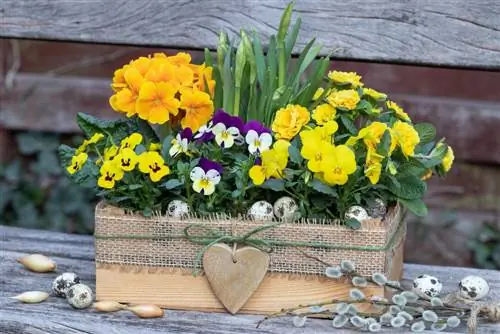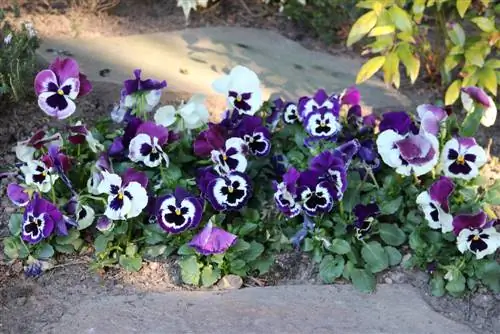- Author admin [email protected].
- Public 2023-12-16 16:46.
- Last modified 2025-01-23 11:22.
They stand adorable in the bed and rejoice with their beautifully designed flower heads. The horned violets are valuable gap fillers and extremely decorative, especially in combination with other creatures of the plant world. But how do you combine them correctly?

Which plants go well with horned violets in beds or balcony boxes?
Squilled violets combine harmoniously with daisies, primroses, mannequins, bluebells, cranesbills, daffodils, squills and purple bells, as they have similar location requirements, growth heights and flowering times.
What factors should you consider when combining horned violets?
To emphasize the graceful appearance of horned violets, it is advisable to consider the following factors when combining:
- Flower color: white, yellow, orange, pink, red, violet or blue
- Flowering time: March to October
- Location requirements: sunny to partially shaded, moist and humus-rich soil
- Growth height: 15 to 20 cm
It is extremely important to take into account its low height when combining with the horned violet. It should always be placed in the foreground, otherwise it will quickly be overshadowed by taller plants and ultimately disappear visually.
Plant plants next to horned violets that also thrive in partial shade or full sun. Specimens that prefer moist substrates are particularly recommended.
Thanks to their long-lasting flowering period and their wide color spectrum, horned violets can be combined with numerous other plants depending on your preference in terms of the overall effect.
Combine horned violets in the bed or in the balcony box
In the bed, horned violets like to find a place at the front edge, where they form a visually appealing duo with daisies. Other perennials that remain small or reach a medium height also suit the horned violet. In addition, horned violets can replace early bloomers in their presence: Once daffodils, squills and the like have faded, the horned violets are far from giving up, but continue to bloom tirelessly.
Horned violets can be wonderfully expressed with the following companion plants:
- Daisies
- Bluebells
- Storksbill
- Primroses
- True to men
- Daffodils
- Bluestars
- Purple bells
Combine horned violets with daisies
The combination of horned violets and double daisies is very popular. The two plants remain low and produce flowers that are differently designed but still harmonize with each other. The daisy is also quite persistent and can show its flowers until autumn. Horned violets and daisies also agree on location.
Combine horned violets with primroses
When the primrose season comes to an end, the horned violets are still present for a long time and enrich the location with their splendor of flowers. The two should be planted next to each other at approximately the same height as their growth height is similar. Since they have similar demands regarding the location, there is a peaceful neighborhood between them.
Combine horned violets with men's loy alty
If you want to fill a balcony box with horned violets, you can combine the delicate plant fantastically with men's faithful (blue lobelia). Violet-white horned violets are particularly pretty when they can be found next to violet to blue males. This makes for a lovely ensemble. Yellow or orange horned violets appear more spirited next to the Manntreu.
Combine horned violets as a bouquet in the vase
The interplay of horned violets and pansies in the vase looks particularly colorful and playful. Here you can create a colorful mix. Create a more reserved and elegant bouquet of horned violets in combination with pink or purple columbine, cornflower and pink cranesbill.
- Aquilegia
- Cornflower
- Adderhead
- Storksbill
- Pansies
- Zinnias






